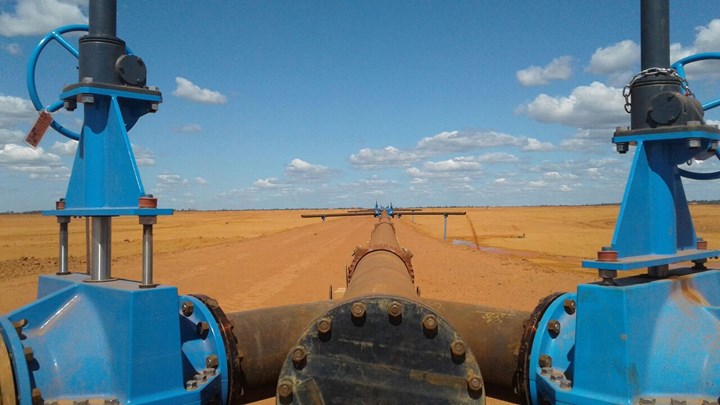Going the Distance: Mining’s Race to Meet Global Technology Thirst
When it comes to the world’s persistent and growing need for more raw materials, mining pushes forward to meet this moment while simultaneously striving toward decarbonization.
#automation #materials
“That they want to do what? That’s insane.” That’s the first thought that came to mind when someone told me quite a few years ago the amount of slurry a customer wanted to pump across places like the Amazon jungle, a vast desert or even across a whole mountain range. But they (direct customers and EPCs) weren’t insane; they were just pushing the mining industry forward. Pushing for engineering departments at different companies globally to come up with ideas and develop the infrastructure to support the needs of an ever-evolving mining market.
The need for mining is still there, and although alternative sources of energy are evolving, different industries still rely on raw material and precious metals to be extracted from remote places. This is to respond to customer needs and their constant requests for lighter, faster, more reliable and longer-lasting products (i.e., cars, phones, fiber optics, laptop computers, power sources).

Pinch valves controlling the distribution of tailings at a massive bauxite tailings dam in Brazil
A clear example of this trend was when a well-known EPC (engineering procurement and construction) company was retained by one of the largest global mining companies to perform a full range of engineering services on a massive-scale project located in Brazil. The project was an integrated system comprising open-pit mines, a beneficiation plant, a 500+ km slurry pipeline, a filtering plant and an export terminal at the Atlantic port of Açu.
At the time, the pipeline was the longest iron concentrate pipeline in the world, in addition to moving the most tonnage. The system now extends through difficult terrain throughout its length. The 24/26-in. diameter pipeline system was designed to transport more than 25 million tons per year of iron ore from an elevation above 700 meters, through many municipal districts and eventually to terminal facilities on the coast of Brazil.
As consumers request better, faster and lighter products, these requests trickle down to suppliers of such products’ raw materials.
Suppliers of raw material in the mining industry will send out bids into the market for engineering houses (EPCs) to compete against each other on projects that sometimes seem unrealistic.
However, and this is something that drove me to the industry, engineering houses will get to work on new and inventive models to extract larger quantities of raw materials in the shortest amount of time so they can turn over the keys to their customer when the projects are done.
Some of these raw materials that we may take for granted in our everyday lives consist of:
- Copper is used for many things because it is a great conductor of electricity. It is used in generators, motors and electronic goods. Copper conducts heat well; therefore it is also used in vehicle radiators, air conditioners and home heating systems. Its use in the plumbing industry is also well known for its antimicrobial properties and malleability.
- Iron ore is the source of primary iron for the world's iron and steel industries. It is essential to produce steel, which in turn is essential to maintain a strong industrial base and keep construction going globally.
- Bauxite, a naturally occurring ore containing variable amounts of hydrous, is used to make alumina. Alumina and bauxite are the two main raw materials in the aluminum-making process. Aluminum with its soft and malleable properties, will go on to become cans, foils, utensils, window frames and airplane/car parts.
- Lithium, which between 2008 and 2018 saw a drastic increase from 25,400 to 85,000 tons in annual production in the major producing countries. It’s used for batteries for electric vehicles, laptops and cell phones. Some lithium, in the form of lithium carbonate or lithium citrate, is used as medicine to treat the inflammation of joints and to treat serious mental illness.
This latest explosion in lithium production didn’t just happen; the major producers of it (JGL Co. Ltd, Albemarle, Tianqi, SQM, and Pilbara, amongst others) had to go out and ramp up their output to satisfy consumers’ thirst for the newest phone and electric vehicles and other similar products requiring lithium batteries.
And although the pandemic has slowed down or delayed some of the newer, larger mining projects throughout the world, we are still in the middle of the race to come up with better, more complex ways to extract the minerals and transport them at higher pressures, with larger pipelines, over longer distances.
About the Author
Danilo Garcia is the president of RF Valves Inc. and oversees all operations of the company. He focuses on business development and sales growth in the mining/industrial/municipal sectors and travels the United States and internationally to secure business and support major projects. Garcia has more than 20 years of experience in the valve industry and has been at the helm of RF Valves for the past eight years.
RELATED CONTENT
-
Testing of Hydrogen Valves
Valves are used to control all types of fluids, and while some are easy to manage, others can be a challenge. At the top of the challenging list sits hydrogen, the smallest, lightest molecule known to man.
-
The Limits of Standard Manual Globe Valves for Throttling
A common practice in process services is to use manual globe valves with hand wheels for regulating flow.
-
General Considerations for Control and Choke Valves Used in Offshore Oil and Gas Production
The application of control and choke valves used in offshore oil and gas production is a very broad field and in this article, some of the main considerations for valve selection will be addressed.







 Unloading large gate valve.jpg;maxWidth=214)


